2025-05-07 ジョージア大学(UGA)
 Researchers working with fire ants are trying to understand how a small group of ants can convince a larger group to change a fundamental aspect of their behavior—whether they kill or nurture multiple queens. Their work was published this week in the Proceedings of the National Academy of Sciences. (Photo: Contributed)
Researchers working with fire ants are trying to understand how a small group of ants can convince a larger group to change a fundamental aspect of their behavior—whether they kill or nurture multiple queens. Their work was published this week in the Proceedings of the National Academy of Sciences. (Photo: Contributed)
<関連情報>
- https://ecology.uga.edu/a-minority-can-influence-whole-group-to-change-study-finds/
- https://www.pnas.org/doi/10.1073/pnas.2501740122
ヒアリにおける社会組織の転換は少数のコロニーメンバーによって誘導される 間接的遺伝効果の解明 Conversion of social organization in fire ants induced by few colony members: Unmasking indirect genetic effects
Haolin Zeng, Kenneth G. Ross, and Takao Sasaki
Proceedings of the National Academy of Sciences Published:May 6, 2025
DOI:https://doi.org/10.1073/pnas.2501740122
Significance
Groups of social animals, including humans, can make complex decisions without a single central leader. Surprisingly, a minority within a group sometimes can sway the majority to adopt its preferences—a phenomenon known as “minority influence.” In fire ant colonies, a small subset of workers carrying a selfish genetic element influences their nestmates to accept additional queens that also carry this element, shifting the colony from a single-queen to a multiple-queen social structure. Our experiments reveal that chemical (pheromonal) communication between workers of different genotypes is crucial in this social conversion. By demonstrating how local interactions drive the emergence of collective social phenotypes, we offer fresh perspectives on the role of selfish genetic elements in shaping complex group behaviors.
Abstract
Genes and the environment jointly shape individual traits, but the influence of indirect genetic effects (IGEs), arising from the genetic composition of interacting conspecific individuals, is often ignored or underemphasized. Moreover, because of practical challenges in characterizing IGEs, empirical research has fallen behind theoretical advancement. The fire ant Solenopsis invicta offers a uniquely suitable study system due to its distinct colony-level phenotypic variation (monogyne and polygyne social forms) attributed to IGEs of a social-supergene variant (b allele). A minority of b-carrying workers (Bb genotype) can trigger colony-level conversion from monogyne (single queen per colony) to polygyne (multiple queens per colony) behavior. This study investigated the mechanisms underlying this process via 400-ant microcolonies. We first showed that assimilated Bb workers reduce aggression by host BB workers toward Bb queens, thus inducing polygyny, at rates observed earlier in experiments that used full-size (>20,000 ants) colonies. We then demonstrated that social conversion is facilitated by cuticular contact between the worker types, and verified the presence of nonvolatile cuticular pheromones that are necessary but not sufficient components underpinning this process. Follow-up experiments suggested that a second, polygyne worker-produced pheromone that is only released once such workers detect a Bb queen is also necessary but again insufficient, for full expression of the conversion phenomenon. Thus, multiple pheromonal components linked to presence of the b supergene allele in colony workers appear to be involved in shaping social environments and thereby inducing, via IGEs, the transformation from monogyne to polygyne fire ant societies.


